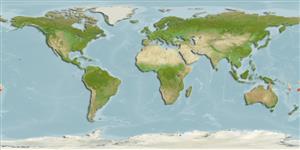>
Ophidiiformes (Cusk eels) >
Dinematichthyidae (Viviparous brotula)
Etymology: Dermatopsis: Greek, derma = skin + Greek, opsis = appearance (Ref. 45335); greenfieldi: Named for David. W. Greenfield, Moss Landing Marine Lab, USA...
More on authors: Møller & Schwarzhans.
Environment: milieu / climate zone / depth range / distribution range
Écologie
marin récifal; profondeur 1 - 10 m (Ref. 57886). Tropical
Central Pacific: Fiji.
Taille / Poids / Âge
Maturity: Lm ? range ? - ? cm
Max length : 5.3 cm SL (female)
Description synthétique
Clés d'identification | Morphologie | Morphométrie
Rayons mous dorsaux (Total) : 64 - 70; Rayons mous anaux: 44 - 49; Vertèbres: 39 - 41. This species is characterized by the following: vertebrae 11-12 + 27-29 = 39-41, dorsal fin rays 64-70, anal fin rays 44-49; body with scales; eye 1.8-2.6 % SL, sharp spine on ventral maxilla positioned behind rear tip of eye; otolith with pointed posterior tip and weak postdorsal angle, it is elongate, length to height ratio 2.1-2.2, sulcus with separated colliculi (Ref. 57886); large, broad single pair of (outer) pseudoclaspers, inwardly connected to isthmus with ligament, and has 2 supporters, the anterior inclined, short, joined at base to massive and long posterior supporter (Ref. 76869).
Life cycle and mating behavior
Maturities | Reproduction | Spawnings | Egg(s) | Fecundities | Larves
Møller, P.R. and W. Schwarzhans, 2006. Review of the Dinematichthyini (Teleostei, Bythitidae) of the Indo-west Pacific, Part II. Dermatopsis, Dermatopsoides and Dipulus with description of six new species. The Beagle 22:39-76. (Ref. 57886)
Statut dans la liste rouge de l'IUCN (Ref. 130435)
Menace pour l'homme
Harmless
Utilisations par l'homme
Outils
Articles particuliers
Télécharger en XML
Sources Internet
Estimates based on models
Preferred temperature (Ref.
123201): 26.8 - 29.3, mean 28 °C (based on 247 cells).
Phylogenetic diversity index (Ref.
82804): PD
50 = 0.5312 [Uniqueness, from 0.5 = low to 2.0 = high].
Bayesian length-weight: a=0.00389 (0.00180 - 0.00842), b=3.12 (2.94 - 3.30), in cm total length, based on all LWR estimates for this body shape (Ref.
93245).
Niveau trophique (Ref.
69278): 3.2 ±0.5 se; based on size and trophs of closest relatives
Fishing Vulnerability (Ref.
59153): Low vulnerability (10 of 100).
